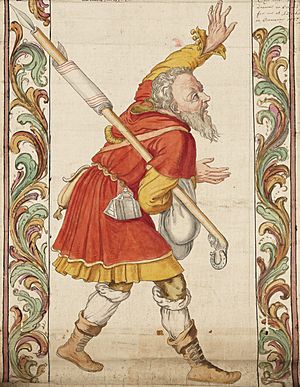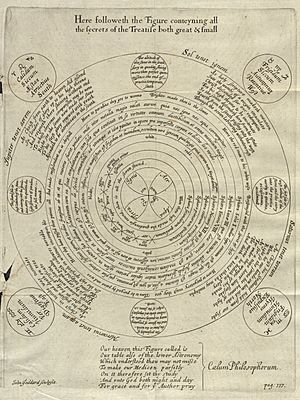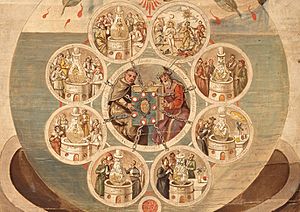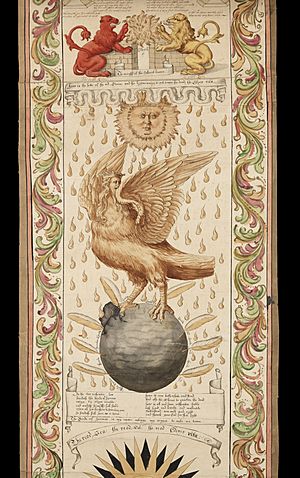George Ripley (alchemist) facts for kids
Quick facts for kids
Sir
George Ripley
|
|
|---|---|

Ripley, as illustrated in a 16th-century edition of the Ripley Scroll
|
|
| Born | c. 1415 |
| Died | 1490 (aged 74–75) |
|
Notable work
|
The Compound of Alchemy, Cantilena Riplaei, The Ripley Scroll (disputed) |
|
Main interests
|
Alchemy |
|
Influenced
|
|
Sir George Ripley (around 1415–1490) was an English Augustinian canon (a type of priest), writer, and alchemist. An alchemist was someone who tried to turn ordinary metals into gold and find a way to live forever.
Contents
George Ripley: A Famous Alchemist
George Ripley was one of England's most well-known alchemists. His writings about alchemy were popular when they first came out in the 1400s. People continued to study them in the 1500s and 1600s.
Who Studied Ripley's Work?
Famous thinkers like the alchemist John Dee read Ripley's books. Even Robert Boyle, who is often called the first modern chemist, and Isaac Newton, a brilliant scientist, studied Ripley's ideas.
Ripley's Travels and Books
There are many interesting stories about Ripley. Some say he studied in Italy for 20 years and was a favorite of Pope Innocent VIII. While these might be myths, he did spend several years traveling in Europe.
After returning to England, he wrote his important book, The Compound of Alchemy. This book was also called The Twelve Gates leading to the Discovery of the Philosopher's Stone. He finished it in 1471. He also wrote Cantilena Riplaei, which was one of the first poems about alchemy.
A Generous Gift?
Another story about Ripley comes from a writer named Thomas Fuller. He wrote that Ripley supposedly gave a huge amount of money, one hundred thousand pounds, every year to the Knights of Malta. This money was said to help them fight against the Turks.
Ripley was known as the "Canon of Bridlington". He spent his later years living a quiet life as an anchorite (someone who lives alone for religious reasons) near Boston in Yorkshire.
The Wheel: An Alchemical Drawing

Some experts believe that Ripley's book, The Compound of Alchemy, should be understood by looking at a special drawing he made called the Wheel. This drawing is like a map of our solar system. Back then, people thought the Earth was at the center.
Planets and Elements
Ripley hid his alchemy recipes in this drawing. He showed them as planets orbiting the Earth. In alchemy, there's often a link between the heavens and the Earth. This link is shown using seven planet symbols:
- Sol (Sun) for gold
- Luna (Moon) for silver
- Mercurius (Mercury) for quicksilver (mercury)
- Venus for copper
- Mars for iron
- Jupiter for tin
- Saturn for lead
The Vision of Sir George Ripley
An English alchemist named Eirenaeus Philalethes wrote explanations about Ripley's works. Ripley's Vision, which was part of his Twelve Gates book, was explained by Eirenaeus in 1677. This "Vision" was written in a very symbolic and mysterious way. It describes a strange dream or experience that Ripley had, using hidden meanings to talk about alchemical processes.
The "Ripley Scroll"
There are about 23 copies of something called the Ripley Scroll still existing today. These scrolls are different in size, color, and how much detail they have. But they are all based on an original scroll from the 1400s that is now lost.
Why is it Called Ripley Scroll?
Even though these scrolls are named after George Ripley, we don't have proof that he actually drew them himself. They are called Ripley scrolls because some of them include poems and writings linked to him. The pictures on the scrolls are symbolic clues about how to make the philosopher's stone. The philosopher's stone was a legendary substance that alchemists believed could turn base metals into gold and make people immortal.
Where to Find Copies
You can find copies of the Ripley Scroll in different places:
- London, British Library, Add MS 5025 (Four scrolls drawn in Lubeck in 1588)
- London, Science Museum, A21950 (from the 1700s)
- London, Wellcome Institute, 692 & 693 (two scrolls from the 1500s)
- Cambridge, Fitzwilliam Museum, MS 276 (from the 1500s)
- Oxford, Bodleian Library MS Bodl Rolls 1
- Oxford, Bodleian Library MS Ash. Rolls 40
- Oxford, Bodleian Library MS Ash. Rolls 52
- Oxford, Bodleian Library MS Ash. Rolls 53
See also
 In Spanish: George Ripley para niños
In Spanish: George Ripley para niños



